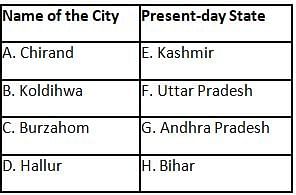KTET Paper 2: Social Science Test - 10 - KTET MCQ
30 Questions MCQ Test KTET Mock Test Series 2024 - KTET Paper 2: Social Science Test - 10
After the ______, Mahatma Gandhi called off the Non-Cooperation Movement.
A constitutional government by definition is a
| 1 Crore+ students have signed up on EduRev. Have you? Download the App |
In teaching Social Studies, question answer technique is effective as it ensures
'Kamala' bought one dozen Shimla apples last week at a price of Rs. 200. She bought two dozen this week for Rs. 550. This transaction
A teacher gives the following exercise to her students:
"Imagine you are a member of a nomadic community that shifts residence every 3 months. How would this change your life"?
This question will
Throughout the 19th century, most educated women were taught at home by liberal fathers and husbands instead of sending them to schools.
Which of the following statements is not a correct reason for the above trend?
When did Tipu Sultan become the ruler of Mysore?
Statement (A): Panchayati Raj is the third tier of government.
Statement (B): It comes under the feature of federalism in India.
Choose the correct/appropriate option regarding federalism in India.
Which among the following is typically used to display all kinds of creative works of students in the classroom?
The product of two fractions is 14/15 and their quotient is 35/24. The greater fraction is
A body of mass 2 kg is thrown up vertically with a kinetic energy of 490 J. The height at which the kinetic energy of the body becomes half the initial value is (g = 9.8 m/s2)
If the diameter of the Earth becomes two times its present value and its mass remains unchanged, then the weight of an object on the surface of the Earth becomes/remains
In ancient times, messages were sent through postcards, and took a lot of time to reach their destination. These days messages are sent with a click of a button and reach almost instantly. What is the primary necessity of sending messages? In what ways the process of the exchange of messages has changed?
This question attempts to assess student's ability to ________.
When was the Act enacted to abolish bonded labour?
Cited below are some sites and present-day states where the evidences of grain and bones of domestic animals have been found. Match them in correct order.

Which one of the following project types has been suggested by Thomas M. Risk for secondary schools?
Valuing observable facts over individual preferences in deriving deduction is called:
Panna district of Madhya Pradesh is famous for which mineral?
The purpose of field work in the teaching of social science is:
To attend the individual differences in the class, what should the teacher of Social Science do?
Only one side of the moon is visible from the earth because
Note taking is one of the methods of teaching Social Studies.
It is based on which of the following assumptions?
To prevent cynicism among students about democratic institutions, which two of the given options would be most appropriate?
A. Emphasise ideal functioning and principles.
B. Indicate impossibility of changing institutions.
C. Emphasise that social inequality is inevitable.
D. Indicate the role of informed public.
The 'Sima' layer of the Earth is made up of ________.
The demonstration method is used in social science teaching and learning when_________.
Which of the following questions assesses the 'comprehension' skill of learners?
A. Which element is the most ductile material?
B. Define gravity
C. List the three highest Mountains in the world
D. Define Democracy. How does the constitution of India divide the electoral process across the country?
E. What are the protocols/safety guidelines a person should follow in COVID-19-affected zones?
Choose the correct option.
In which of the two Harappan sites has evidence for the fire altars been found?
Portfolio is an important tool of continuous and comprehensive evaluation because it
Field trips are useful in Social Sciences for
|
100 tests
|























